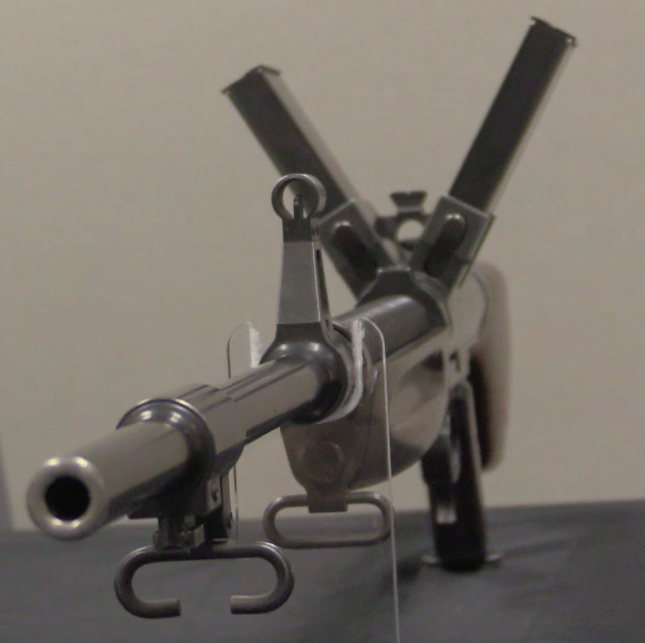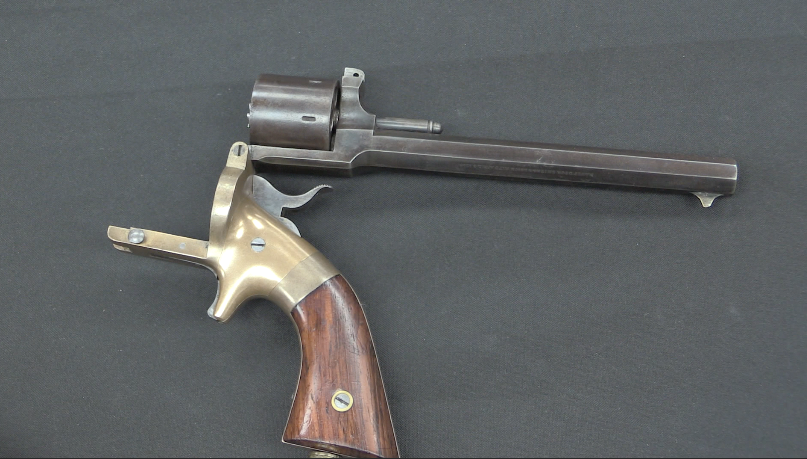Johnson M1941 rifles were used in limited numbers by the US Marine Corps in the Pacific theater of World War Two, but they were used – and generally well liked. Interestingly, there was a fairly common field modification done by the Marines, and that was to cut off the front sight wings, and sometimes cut the rear aperture into a deep V-notch or a flat U-notch style. This particular ex-Marine rifle shows both of these modifications.
Related Articles

Artillery
Hotchkiss Revolving Cannon tests

Prototype


A suitable rifle for ban states today, sans bayonet mount.
Many collectors worship at the altar of “original as it left the factory” and would immediately want to “fix” the boogered front and rear sights with unaltered parts. Maybe not so fast when Uncle Sam’s Misguided Children doing the unauthorized damage.
Conversely, we have ethically challenged people who observe that “Marine Johnsons are more valuable” and proceed to get out their hacksaws and files and chop away at any Johnson they can find, creating false history.
Which is an echo of the conflict between collectors who want their “flintlock muskets” to be flint locks, and “reconvert” those which were converted to percussion, and likely saw use in the Civil War as percussion arms. Or, M1892 Krags which were updated to Model 1896 configuration, or M1903 Rod bayonet rifles altered to knife bayonet after 1905, which are tempting to unconvert. While some collectors wisely grant legitimacy to the arms in their “evolved configuration, others want to undo history.
Altered arms are very interesting, and have their own history, which should be appreciated and respected. Likewise, collectors need to be aware that some folks like to undo, or in some cases, falsify history for fun or profit.
BTW, I once had several Johnsons from the estate of the Paramarine armorer, which I sold off. Sadly, this was BEFORE Bruce Canfield’s excellent book came out which confirmed one of them was indeed a USMC rifle. Happily, it went to a very serious Johnson collector where it is fully appreciated.
Ain’t that the bitch of being “before your time” as a collector? Or, even, right place, right time, wrong information?
Circa 1984-ish, I’m at a gun show in Oklahoma. I think it was the big one in OKC, but it might have been the satellite show the same guys did in Lawton. I wander through, clutching my E-3 pay pennies, and I run across a guy who’s actually selling a collection of stuff I had only ever seen in Ezell’s Small Arms of the World. His kids weren’t interested, and he was tapping out before going into a retirement community in Arizona, so everything he had needed to go.
He had a bunch of Johnson stuff, all of which was at the lowest price on his table. I looked at it all, appreciatively, BS’ed with him a little, and wandered on. I distinctly remember one of the Johnson rifles, which was “not like the others”, and which he said was a prototype “product-improved” version that had gone from the factory to the Pacific Theater and then back after combat action was seen. It had the sight mods and a few other things, including a bipod worked into the stock from the LMG. No idea what the real deal was, but he claimed it was legitimate. I wish I had possessed the wit and wisdom to buy everything he had, but at the time? LOL… Not happening. He had some interesting items, that’s for sure.
Also missed out on a lot of consecutive-serial number pre-WWII Lugers with all accessories, that I could have picked up for a song in Germany due to firearms laws. I was told by the BATF when I inquired that they weren’t importable, so I passed. Years later, a BATF agent I made friends with (and, who was a Luger collector…) freaked right the hell out when I told him, because those pistols were eminently importable at the time I inquired… Those pistols were worth an unGodly sum of money, when he toted it all up. Sadness all the way around…
Ian leaves out the First Special Service Force, who reputedly traded off some early plastic explosives to the Paramarines for enough Johnson LMG’s to arm the Force… I think it was C-3, a precursor to C-4.
Robert T. Frederick, the 1st SSF commander, doesn’t get enough credit for using his supply staff creatively and giving them the freedom to do things out of the ordinary in the early days of WWII.
I have a Johnson rifle and my father who carried the LMG was very interested in the Johnson carbine which he figured after canfields book used a shortened rifle upper receiver. We tried to locate a damaged upper rifle receiver in order to make a copy. We never located one thought other parts were available. dad is gone but I am still looking for one of the receivers, Dad estimated that about 2and5/8 of an inch was removed from the rear. Would anyone one know where I might locate one or more of those e receivers as my grand sons and grand daughter love shooting my rifle.
personal wartime memoir of a Mo. country boy related how he couldn’t adjust to his BARs sights, so he filed himself a notch in it. Scored Expert on the range. When his CO saw what he’d done to his weapon, his score was downgraded and he had to pay for a set of new sights.
Awesome piece on a cool rifle, great stuff as always Ian. Mine still groups well at 200 yards. For all, the book about Melvin Johnson and his guns by Bruce N. Canfield is pretty great.
I feel that aperture sights work well on the range, but I prefer a notch sight myself. It allows you to keep both eyes open if you want, and maintain a better sense of situational awareness.
The Germans used notch sights on the MG 42 and the StGw 44, and the Russians kept them on AKs. I can see why Marines used to notch sights preferred them.